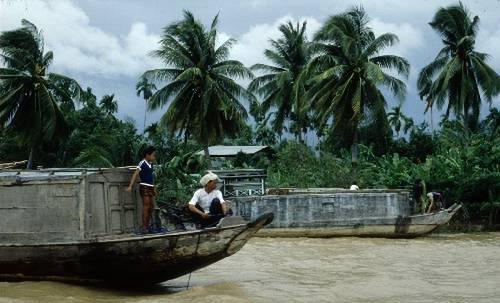
The Mekong River is one of the principal rivers of Southeast Asia. In southern Vietnam, people use the river as an inexpensive transportation route. After passing through Vietnam, the Mekong enters the South China Sea.
Tônlé Sap ,shallow lake, western Cambodia. The largest lake of Southeast Asia, it is fed by numerous streams; it drains by the Tônlé Sab River southeast to the Mekong River. During the wet monsoon season of June to November, the high waters of the Mekong River reverse the flow of the Tônlé Sab River and increase the size of the lake from 2600 to 10,400 sq km (about 1000 to 4,020 sq mi). Fishing is important on the lake.
Cambodia’s principal lake, the Tônlé Sap (Great Lake), is the largest in Southeast Asia. From the northwest, the Tônlé Sap drains into the Mekong via the Tônlé Sab River, entering the Mekong at Phnom Penh. Each year during the monsoon season (approximately May to October), the waters of the Mekong increase and reverse the flow of the Tônlé Sab, which begins to drain into the lake. The lake then expands dramatically, flooding the provinces along its banks. When dry weather returns, the river reverses its course again and flows back into the Mekong, draining the northwestern provinces. At the height of the flooding, the Tônlé Sap reaches more than 10,000 sq km (4,000 sq mi), or about four times its size in the dry season. The lake is one of the richest sources of freshwater fish in the world.
| Mekong River, Vietnam The Mekong River is one of the principal rivers of Southeast Asia. In southern Vietnam, people use the river as an inexpensive transportation route. After passing through Vietnam, the Mekong enters the South China Sea. |
Mekong The basin of the Mekong is an important agricultural area, with rice as the main crop. Without irrigation, rice cultivation is impossible during the long dry season. The United Nations (UN) started the Mekong River Development Project in 1957 to improve flood control, navigation and irrigation, and to develop hydroelectric power plants along the river. However, the project's progress was impeded by the Vietnam War (1959-1975) and political instability in Cambodia and other countries in the region. In the 1990s interest was renewed in developing the hydroelectric power potential of the Mekong River. Officials from four of the six nations that share the Mekong—Cambodia, Laos, Thailand, and Vietnam—met to make plans regarding this development; China and Myanmar did not attend the talks. By 1996, 54 dams were scheduled to be built on the Mekong. Manwan Dam in China's Yunnan Province was the first to be completed; it began producing power in 1993. Thailand completed Pak Mun Dam in 1994. Some of the nations involved have voiced concerns about the dam construction. The nations downriver worry that China's dam plans will interfere with the flow of the river, either flooding land downriver or changing the nature of the river so that hydroelectric projects downstream will lose some of their power potential. Additionally the two existing dams have had a negative effect on the environment, flooding certain areas and destroying fish habitats, which affects the fishing industry of native villagers.
(Tibetan Dza-chu; Chinese Lancang Jiang; Thai Mae Nam Khong), river in southeastern Asia, the longest river in the region. From its source in China's Qinghai Province near the border with Tibet, the Mekong flows generally southeast to the South China Sea, a distance of 4,200 km (2,610 mi). The Mekong crosses Yunnan Province, China, forms the border between Myanmar (formerly known as Burma) and Laos and most of the border between Laos and Thailand, and flows across Cambodia and southern Vietnam, emptying into the South China Sea. In the upper course are steep descents and swift rapids, but the river is navigable south of Louangphrabang, Laos. French explorer Michel Peissel discovered the source of the Mekong in 1994 at a high mountain pass.